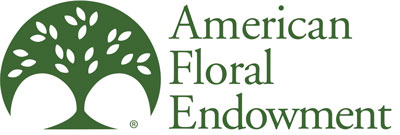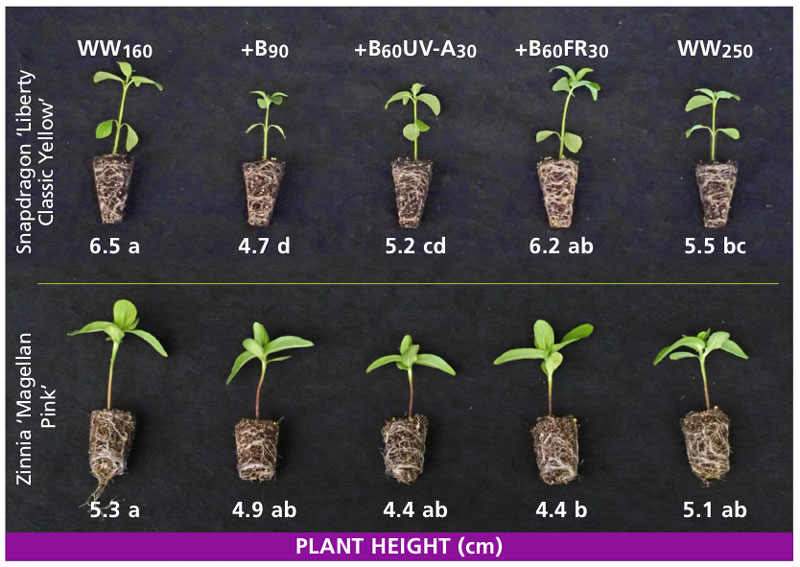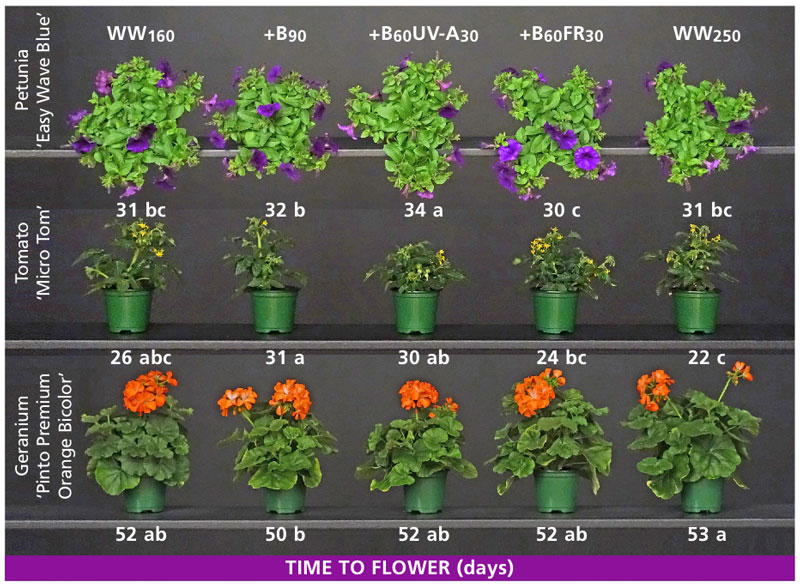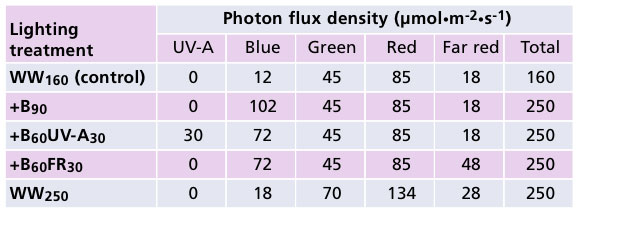4/1/2021
Sole-Source for Seed
Annika Kohler & Erik Runkle

Indoor production of high-value crops, such as leafy greens and floriculture transplants, continues to increase because of the ability to consistently produce uniform plants year-round, and sometimes with higher quality or specifically desired characteristics.
Blue (400 to 500 nm) and red (600 to 700 nm) light-emitting diodes (LEDs) are commonly used because these wavebands are highly absorbed by leaves. Additional types of LEDs have been gaining interest, including white and far red (FR, 700 to 800 nm). White LEDs are inexpensive and provide a broad spectrum of light, including blue, green, red and a little FR. FR light promotes stem and leaf elongation, and for some long-day plants and a few others, can promote flowering.
 Figure 1. Stem height (cm) of snapdragon and zinnia seedlings after growing under lighting treatments for the final seven days of plug production. The lighting treatments consisted of 160 µmol•m-2•s-1 of light from warm-white (WW) LEDs without or with 30, 60 or 90 µmol•m-2•s-1 of blue (B), UV-A, and/or far-red (FR) light. Stem heights followed by the same letter are statistically similar.
Figure 1. Stem height (cm) of snapdragon and zinnia seedlings after growing under lighting treatments for the final seven days of plug production. The lighting treatments consisted of 160 µmol•m-2•s-1 of light from warm-white (WW) LEDs without or with 30, 60 or 90 µmol•m-2•s-1 of blue (B), UV-A, and/or far-red (FR) light. Stem heights followed by the same letter are statistically similar.
By producing plants indoors under sole-source lighting, not only can we control plant traits by manipulating the light quality and/or quantity, but we can potentially produce more resilient plants that have more protection from environmental stressors. When plants are exposed to high-light levels, UV-A (315 to 400 nm), or blue light, they can accumulate anthocyanins. These pigments make leaves more purple in color and generally increase their tolerance to stressful environments. Additionally, leaves that are exposed to FR or blue light may exhibit a decrease or increase of chlorophyll content, becoming lighter or darker green, respectively.
We performed an indoor lighting study with seedling plugs in an attempt to increase the protective compounds in leaves to increase plant resilience and post-transplant performance. One week before transplant, we grew them under an elevated light intensity or with additional blue, FR and/or UV-A light. We postulated that an increase in light intensity or elevated intensities of blue and/or UV-A light would stimulate anthocyanin accumulation and better tolerate stressful conditions.
Experiment setup
Seeds of Dianthus Super Parfait Raspberry, Geranium Pinto Premium Orange Bicolor, Petunia Easy Wave Blue and Wave Purple Improved, and Snapdragon Liberty Classic Yellow were sown into 162-cell trays by Raker-Roberta’s Young Plants and picked up seven days later. Seeds of Tomato Micro Tom and Zinnia Magellan Pink were sown into 128-cell trays at Michigan State University. Upon arrival or seed sow, all seedlings were placed onto growing racks in the Controlled-Environment Lighting Laboratory (CELL) at MSU that provided a total photon flux density (PFD) of 160 µmol•m-2•s-1 from warm-white (WW160) LEDs for 18 hours per day at an air temperature of 68F (20C).
 Figure 2. Days from transplant to flowering of petunia, tomato and geranium after plugs received five LED lighting treatments during the last seven days. The lighting treatments consisted of 160 µmol•m-2•s-1 of light from warm-white (WW) LEDs without or with 30, 60 or 90 µmol•m-2•s-1 of blue (B), UV-A, and/or far-red (FR) light. Days to flower followed by the same letter are statistically similar.
Figure 2. Days from transplant to flowering of petunia, tomato and geranium after plugs received five LED lighting treatments during the last seven days. The lighting treatments consisted of 160 µmol•m-2•s-1 of light from warm-white (WW) LEDs without or with 30, 60 or 90 µmol•m-2•s-1 of blue (B), UV-A, and/or far-red (FR) light. Days to flower followed by the same letter are statistically similar.
One week before seedlings were ready to transplant, trays were placed under five LED lighting treatments consisting of WW160 alone (control treatment) or with an additional 90 µmol•m-2•s-1 of blue light (+B90), 60 and 30 µmol•m-2•s-1 of blue and UV-A (+B60UV-A30) light, 60 and 30 µmol•m-2•s-1 of blue and FR light (+B60FR30), or 90 µmol•m-2•s-1 of WW (WW250; Table 1).
When seedlings were ready for transplant, we measured leaf chlorophyll content via a soil plant analysis development (SPAD) meter, overall leaf color using hue angle values (colorimeter), fresh and dry shoot mass, leaf area and stem height. All plants were then placed in a dark growth chamber at 86F (30C) with a relative humidity of 65% for two days to simulate stressful transportation conditions.
After the stress treatment, we measured SPAD and hue angle values again, then transplanted the seedlings into 4.5-in. pots and placed them in a greenhouse with a 16-hour photoperiod supplemented by high-pressure sodium lamps and an average temperature of 68F (20C). We grew them in the greenhouse until flowering, and recorded the date of first open flower and stem height upon first open flower for each plant.
 Table 1. The photon flux density of UV-A (315 to 400 nm), blue (B, 400 to 500 nm), green (500 to 600 nm), red (600 to 700 nm) and far-red (FR, 700 to 800 nm) light, and their totals for five LED lighting treatments delivered for one week at the end of the plug stage.
Table 1. The photon flux density of UV-A (315 to 400 nm), blue (B, 400 to 500 nm), green (500 to 600 nm), red (600 to 700 nm) and far-red (FR, 700 to 800 nm) light, and their totals for five LED lighting treatments delivered for one week at the end of the plug stage.
Results
Seedlings. Lighting treatments only affected stem height of dianthus, snapdragon and zinnia. For example, zinnia was 20% taller under the control compared to +B60FR30 (Figure 1). In contrast, snapdragon was 17% to 37% taller under the control compared to all other treatments except for +B60FR30 (Figure 1). With the exception of geranium and Petunia Easy Wave Blue, the fresh and dry shoot mass and leaf area typically decreased with an additional 60 or 90 µmol•m-2•s-1 of blue light.
For instance, fresh shoot mass and leaf area of Petunia Wave Purple Improved were 24% to 27% smaller under +B90 than the +B60UV-A30 or +B60FR30 treatments. The additional 90 µmol•m-2•s-1 of blue light decreased the dry shoot mass of dianthus and snapdragon by 23% and 52%, respectively, compared to the control.
Geranium, Petunia Wave Purple Improved, snapdragon and zinnia under the WW250 and/or +B60FR30 treatments had lower SPAD values (i.e., were a lighter green color) than plants grown under the control. In most cases, the stress treatment decreased chlorophyll content across lighting treatments. Hue angle, or color, of the seedlings were usually similar among lighting treatments before being subjected to heat stress. After the stress treatment, due to the reduction in chlorophyll, Petunia Easy Wave Blue and Wave Purple Improved were less green and more purple under the +B90 and +B60UV-A30 treatments compared to the other lighting treatments.
Finished production. Only subsequent flowering of geranium, Petunia Easy Wave Blue and tomato were influenced by lighting treatments (Figure 2). For instance, tomato flowered nine days earlier when grown under WW250 compared to +B90. In contrast, geranium flowered three days earlier under +B90 than WW250. Petunia Easy Wave Blue grown under +B60FR30 flowered four days earlier than those under the +B60UV-A30 treatment. Lighting treatments had no effect on stem height of finished plants.
Conclusions
In this study, we tried to increase the post-shipping and transplant performance of bedding plant plugs by delivering additional light during the last stage of indoor production. Plants received additional blue light without or with UV-A or FR light, or additional white light from WW LEDs. Leaf area, and fresh and dry shoot mass were generally smaller under additional blue light than the control or with the addition of blue and FR light. Chlorophyll content generally decreased after exposure to the stress treatment and purpling of the leaves of petunia (anthocyanin accumulation) was more apparent for plugs provided with the +B90 or +B60UV-A30 lighting treatments.
Despite the LED lighting treatments to the seedlings, there were few persistent effects after transplant. This could be due to the broad spectrum of WW LEDs, which provide blue, green, red and some FR light. Providing seedlings with at least 160 µmol•m-2•s-1 of WW light and at least an additional 60 µmol•m-2•s-1 of blue light can produce compact and dark green plants. GT
Acknowledgements: We thank the American Floral Endowment, OSRAM, Raker-Roberta’s Young Plants and horticulture companies that support the floriculture program at Michigan State University. We also want to thank Nathan Kelly and Nate DuRussel for assistance in this project.
Annika Kohler is a Research Technician, and Erik Runkle (runkleer@msu.edu) is a Professor and Floriculture Extension Specialist in the Department of Horticulture at Michigan State University.